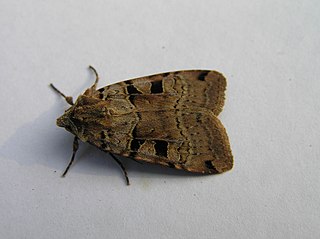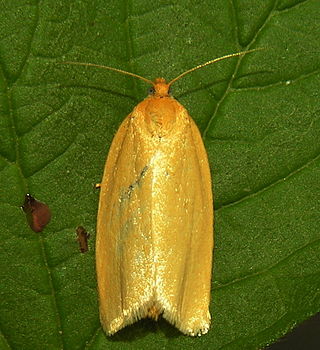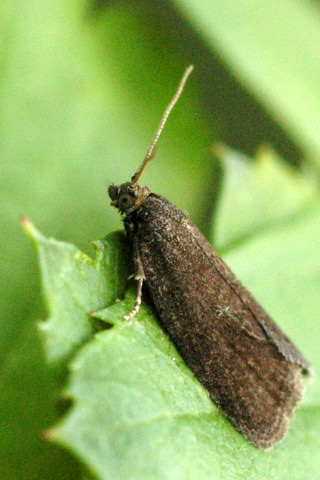
The double square-spot is a moth of the family Noctuidae. It is distributed through most of Europe except Portugal, the Mediterranean islands and northernmost Fennoscandia. In the East, the species ranges East across the Palearctic to Siberia and in the South-East to the Black Sea and in Iran. It rises to a height of about 2000 metres in the Alps.

The minor shoulder-knot is a moth of the family Noctuidae. The species was first described by Johan Christian Fabricius in 1776. It is distributed throughout Europe then east across the Palearctic to Siberia and Japan. It also occurs in Turkey.

The glaucous-winged gull is a large, white-headed gull. The genus name is from Latin Larus which appears to have referred to a gull or other large seabird. The specific glaucescens is New Latin for "glaucous" from the Ancient Greek, glaukos, denoting the grey color of its wings.

Apamea sordens, the rustic shoulder-knot or bordered apamea, is a moth of the family Noctuidae. The species was first described by Johann Siegfried Hufnagel in 1766. It is distributed throughout Europe, east across the Palearctic to Central Asia and to China and Japan. It also occurs in North America.

The black-winged cuckooshrike, also known as lesser grey cuckooshrike or dark grey cuckooshrike, is a species of cuckooshrike found in South to Southeast Asia. Despite the name, they (cuckooshrikes) are unrelated to shrikes or cuckoos. They have broad based bills with grey upper parts, black wings, white vent, graduated white-tipped tails, black bills and legs. Females are overall lighter in all taxa.

The black-winged petrel is a species of seabird in the family Procellariidae. It breeds on a number of oceanic islands in the tropical and subtropical East Pacific Ocean and spends the rest of the year at sea.

Aphelia paleana, the timothy tortrix, is a moth of the family Tortricidae. It is found in Europe, and across the Palearctic to China and the Russian Far East.

Aphelia viburnana, the bilberry tortrix, is a moth of the family Tortricidae. It is found in Europe, from Portugal and Great Britain to the Ural Mountains, Siberia and Mongolia, further east to the Russian Far East.

Colocasia coryli is a moth of the family Noctuidae. It is found in Europe and Asia. In the north of its range, the distribution area includes northern Scandinavia, while in the south the moth is limited to montane areas of western and northern Spain, Sicily, Greece and Asia minor. To the east, the range extends across the Palearctic to Lake Baikal. In the Alps it is found at elevations up to 1600 m.

Apamea oblonga, the crescent striped, is a moth of the family Noctuidae. The species was first described by Adrian Hardy Haworth in 1809. It is found in northern and central Europe, east to southern Russia, Asia Minor, Armenia, Turkestan, Turkey, Iran, southern Siberia, northern Pakistan, Mongolia, China, Sakhalin and Japan

Denticucullus pygmina, the small wainscot, is a moth of the family Noctuidae. It is found in most of Europe, ranging from northern Spain, through Portugal as far north as Finland. In the east it is found across the Palearctic to the Russian Far East and western Siberia. It is also found in North Africa, Turkey, the Caucasus region and northern Iran.

The lobster-clawed moth is a moth of the family Gelechiidae. It is found in most of Europe, except for the Iberian Peninsula and most of the Balkan Peninsula. In the east, the range extends to Siberia and Taiwan.

Trichopteryx carpinata, the early tooth-striped, is a moth of the family Geometridae. The species was first described by Moritz Balthasar Borkhausen in 1794. It is found in most of Europe, east to the eastern Palearctic realm including the Russian Far East, Siberia, and the Ile District, Kazakhstan.

Eriopsela quadrana is a moth of the family Tortricidae. It is found in most of Europe, east to the eastern part of the Palearctic realm.

Trichiura crataegi, the pale eggar or pale oak eggar, is a moth of the family Lasiocampidae. It was first described by Carl Linnaeus in his 1758 10th edition of Systema Naturae. It is found in all of Europe, east to Anatolia and east across the Palearctic to Amur.

Epirrhoe galiata, the galium carpet, is a moth of the family Geometridae.

Epinotia trigonella, the birch epinotia moth, is a species of moth of the family Tortricidae. It is found in most of Europe, east to the eastern Palearctic realm. It is also found in North America.

Aphelia ferrugana is a species of moth of the family Tortricidae. It is found in central and south-eastern Europe, the south-eastern part of European Russia, Ukraine, the Caucasus, Asia Minor, Syria, Iraq and Iran.

Agonopterix kaekeritziana is a moth of the family Depressariidae. It is found in most of Europe east to the Near East and the eastern part of the Palearctic realm.
Aphelia alleniana, the wide-striped leafroller, is a species of moth of the family Tortricidae. It is found in North America, where it has been recorded throughout Canada, as far north as Alaska. In the United States, it has been recorded from Colorado, Maine and Montana.



















